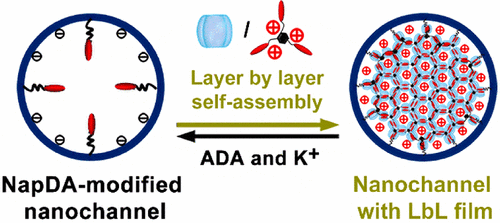当前位置:
X-MOL 学术
›
J. Am. Chem. Soc.
›
论文详情
Our official English website, www.x-mol.net, welcomes your
feedback! (Note: you will need to create a separate account there.)
Supramolecular Self-Assembly Induced Adjustable Multiple Gating States of Nanofluidic Diodes
Journal of the American Chemical Society ( IF 14.4 ) Pub Date : 2016-12-09 , DOI: 10.1021/jacs.6b09601
Ruochen Fang 1 , Huacheng Zhang 2 , Liulin Yang 1 , Huanting Wang 2 , Ye Tian 3 , Xi Zhang 1 , Lei Jiang 2, 4
Journal of the American Chemical Society ( IF 14.4 ) Pub Date : 2016-12-09 , DOI: 10.1021/jacs.6b09601
Ruochen Fang 1 , Huacheng Zhang 2 , Liulin Yang 1 , Huanting Wang 2 , Ye Tian 3 , Xi Zhang 1 , Lei Jiang 2, 4
Affiliation

|
Artificial nanochannels, inheriting smart gating functions of biological ion channels, promote the development of artificial functional nanofluidic devices for high-performance biosensing and electricity generation. However, gating states of the artificial nanochannels have been mainly realized through chemical modification of the channels with responsive molecules, and their gating states cannot be further regulated once the nanochannel is modified. In this work, we employed a new supramolecular layer-by-layer (LbL) self-assembly method to achieve reversible and adjustable multiple gating features in nanofluidic diodes. Initially, a self-assembly precursor was modified into a single conical nanochannel, then host molecule-cucurbit[8]uril (CB[8]) and guest molecule, a naphthalene derivative, were self-assembled onto the precursor through an LbL method driven by host-enhanced π-π interaction, forming supramolecular monolayer or multilayers on the inner surface of the channel. These self-assemblies with different layer numbers possessed remarkable charge effects and steric effects, exhibiting a capability to regulate the surface charge density and polarity, the effective diameter, and the geometric asymmetry of the single nanochannel, realizing reversible gating of the single nanochannel among multiple rectification and ion-conduction states. As an example of self-assembly of supramolecular networks in nanoconfinements, this work provides a new approach for enhancing functionalities of artificial nanochannels by LbL supramolecular self-assemblies. Meanwhile, since the host molecule, CB[8], used in this work can interact with different kinds of biomolecules and stimuli-responsive chemical species, this work can be further extended to build a novel stable multiple-state research platform for a variety of uses such as sensing and controllable release.
中文翻译:

超分子自组装诱导纳米流体二极管的可调多门控状态
人工纳米通道,继承了生物离子通道的智能门控功能,推动了高性能生物传感和发电的人工功能纳米流体器件的发展。然而,人工纳米通道的门控状态主要是通过响应分子对通道的化学修饰来实现的,一旦纳米通道被修饰,它们的门控状态就无法进一步调节。在这项工作中,我们采用了一种新的超分子逐层 (LbL) 自组装方法来实现纳米流体二极管中可逆和可调的多门控特征。最初,自组装前体被修饰成单个锥形纳米通道,然后主体分子 - 葫芦 [8] 脲 (CB[8]) 和客体分子,萘衍生物,通过由宿主增强的 π-π 相互作用驱动的 LbL 方法自组装到前体上,在通道的内表面形成超分子单层或多层。这些不同层数的自组装体具有显着的电荷效应和空间效应,表现出调节单个纳米通道的表面电荷密度和极性、有效直径和几何不对称性的能力,实现了单个纳米通道在多个纳米通道之间的可逆门控。整流和离子传导状态。作为纳米限制中超分子网络自组装的一个例子,这项工作提供了一种通过 LbL 超分子自组装增强人工纳米通道功能的新方法。同时,由于宿主分子 CB[8],
更新日期:2016-12-09
中文翻译:

超分子自组装诱导纳米流体二极管的可调多门控状态
人工纳米通道,继承了生物离子通道的智能门控功能,推动了高性能生物传感和发电的人工功能纳米流体器件的发展。然而,人工纳米通道的门控状态主要是通过响应分子对通道的化学修饰来实现的,一旦纳米通道被修饰,它们的门控状态就无法进一步调节。在这项工作中,我们采用了一种新的超分子逐层 (LbL) 自组装方法来实现纳米流体二极管中可逆和可调的多门控特征。最初,自组装前体被修饰成单个锥形纳米通道,然后主体分子 - 葫芦 [8] 脲 (CB[8]) 和客体分子,萘衍生物,通过由宿主增强的 π-π 相互作用驱动的 LbL 方法自组装到前体上,在通道的内表面形成超分子单层或多层。这些不同层数的自组装体具有显着的电荷效应和空间效应,表现出调节单个纳米通道的表面电荷密度和极性、有效直径和几何不对称性的能力,实现了单个纳米通道在多个纳米通道之间的可逆门控。整流和离子传导状态。作为纳米限制中超分子网络自组装的一个例子,这项工作提供了一种通过 LbL 超分子自组装增强人工纳米通道功能的新方法。同时,由于宿主分子 CB[8],








































 京公网安备 11010802027423号
京公网安备 11010802027423号